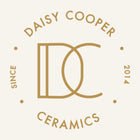There are many ways to apply decoration to your ceramic piece. These can be done on greenware, on bisque, and on glaze.
On Greenware:
Greenware refers to clay when it’s still unfired or ‘raw’. Along the greenware state, your pot can be either at a wet stage, leather-hard stage, or bone-dry stage. Decoration techniques applied to greenware vary depending on the stage where your clay is at, but most are applied during the leather-hard or bone-dry stages. Some of these decoration techniques are:
- Sgraffito: it consists of painting underglaze or slip to a leather-hard surface, let the paint dry, and scratch off parts to create patterns or drawings, revealing the clay colour underneath.
- Carving: it consists of carving away clay to create relief on your pot surface. Carvings can be of various depths and shapes. It is a great way of adding texture to your ceramic pot. This technique is best applied on a soft leather-hard stage, to avoid cracking or breaking.
- Painting with slips or underglaze: you can paint images, shapes and patterns straight onto your ceramic pot to add fun colours different to your clay colour. Underglazes can be applied anytime (even on bisque!) but slips are best applied on a soft leather-hard stage because they need to dry at a similar pace to the clay, in order to prevent it from chipping off.
- Mishima: this technique consists of applying slips onto a pattern that has been carved into leather-hard clay. Then you need to let the piece dry to almost a bone-dry stage. Lastly, scrape the surface with a metal kidney or an arrow head turning tool and you will end up with the carvings showing the slip colour filling. Mishima is good for detailed line drawing designs.
- Water etching: it is the process of painting a resist (shellac or wax) onto a leather-hard surface and letting it dry overnight or until it reaches its bone-dry stage. Then wipe away clay with a damp sponge and you will end up with a relief pattern. Don't worry if the resist you used is coloured because it will burn off during bisque firing :)
- Stamps: you can stamp nearly anything onto your pot to create texture, from tree leaves, fabrics, sticks, or stamp rolling pins that can be bought at the shops. Stamping textures needs to be done strictly onto leather-hard clay, while the surface is firm but not too dry to let the texture create a relief on the clay.
Want to try some of these decoration techniques on greenware? We offer great introductory and more advanced workshops at Clae Space for you to have a go and get creative decorating your handmade ceramics! Head to our website to find out more
On Bisque:
Bisque refers to the stage where clay has been exposed to its first firing, so it’s now ‘cooked’. Bisque firing temperature is between 960 to 1000℃. Some decoration techniques you can apply on bisque are:
- Underglaze pencil drawings: underglaze pencils are sold at most ceramic shops, and they work just like a pencil but on ceramics. Just draw directly on bisque clay (it will look quite pale but after firing the lines will look much brighter and intense) and apply clear glaze on top. Then take to glaze firing. There’s underglaze pencils for different firing temperatures so make sure you’re getting the right one for the type of clay you’re using!
- Tissue transfers: You can actually apply tissue transfers to greenware or bisque. They will work both ways. Tissue transfers work just like kids' tattoos, where you press print side down on the surface you’re working on and damp the back of the paper with a sponge. After a minute you can peel the paper and the design would have transferred from the paper to your clay surface.
- Drawing with glaze: instead of using dipping glaze, there’s brushing glazes which can be used for painting designs and shapes onto your ceramic surface. The non-glazed bits of your composition will expose the clay, which creates an interesting contrast on your finished piece.
- Wax or shellac resist: use cold wax or shellac as a resist. Paint on your bisque surface, then let dry overnight and apply glaze on top. After it’s glaze fired, the bits that used to have the resist will come out unglazed.
On glaze:
Decoration techniques can still be applied on a glazed ceramic. Some of those techniques are:
- Decals: decals work similar to tissue transfers but are applied on a glazed or vitreous surface. To apply decals, first wet the paper (soak in a bowl of water) until the image is released from the paper, like a sticker. Carefully grab the image and set on top of the glazed surface. Repeat until you’ve transferred all your designs onto the ceramic. Then take to a third firing up to 800℃.
- Overglaze paints: these are special paints to be applied on a vitreous surface. They include metallic colours (gold and silver) called lustre. They are, like decals, fired to around 700-800℃, depending on the glaze temperature you’re firing to.

